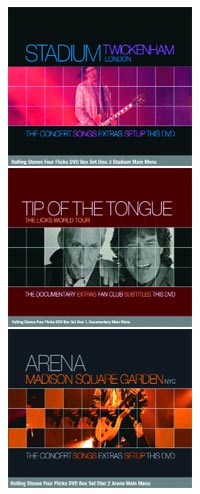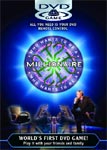One term that might be used to describe the increasingly strong grip DVD has earned in video culture is, simply, acceptance.
Several years ago, many DVD players cost more than $500 and pricey discs could reach $40. While most new technologies tend to be expensive, that was hardly a steady first step toward building a solid installed base.

Metropolis DVD used Sonic Scenarist to author DVD projects for Led Zeppelin and the Rolling Stones
|
Today, however, not only are some decks downright cheap (at $50 or less), but the discs have dropped in price, too - and are just as likely to be found in corporate offices, home studios or even cereal boxes, as at brick 'n' mortar electronics retail stores. Authoring requirements have evolved, too, and creatives need not take that small project to a high-end post house anymore, not when they can turn out smaller projects at home, with basic, affordable tools.
Yes, it is that acceptance of the technology by consumers that has meant an active market. DVD use has permeated society to the point that the Arlington, VA-based Consumer Electronics Association (www.ce.org) started referring to DVD players as "the fastest growing consumer electronics product ever" in mid-2002, with at least one unit in half of the approximately 110 million US households to date.
HD-DVD PLAYERS?
With the SD market the picture of health, the attention within DVD's inner circle has been turned to the natural next frontier, which is high definition (HD).
Meanwhile, content is selling like hotcakes, too. Not only movies, but a plethora of episodic television shows - old and new - and music multi-disc packages, like the Beatles' Anthology, the Rolling Stones' Four Flicks and the Led Zeppelin DVD, all released in 2003. "One thing that is for sure," Hartley says, "is that the public likes bonus content."
Metropolis DVD of New York www.metropolisdvd.com/ designed, produced and authored the Stones and Zeppelin projects. President David Anthony, who executive produced Four Flicks, says the company produces many episodic television and music titles.
" VHS was an awkward format to collect music on, due to its limitations. But with DVDs, the fans can select, watch and listen to higher quality audio and video."

Sonic Solution's Rolf Hartley: One thing is for sure: the public likes bonus content.
|
But the non-technical enthusiasts are creating, as well as viewing. "Consumers are making standard definition DVDs. And with resolution of SD for laptops getting higher and flat screen plasma displays getting sharper," Hartley says to expect HD-DVD to penetrate the US market "in a brisk fashion."
The big question, Hartley continues, is discerning when the HD and home viewing experiences merge. "It's starting now, I think. Enthusiasm for HD titles is coming from consumers and corporations for non-entertainment titles. And source materials are being shot, edited and created in HD."
Ralph LaBarge, president of Alpha DVD www.alphadvd.com/ in Crofton, MD, ran with that thought. "The next two big things" in DVD, he says, "will be dual-layer recordables, as well as HD-capable DVD players. Both the DVD-R and DVD+R camps will release dual-layer burners at some point during 2004. I expect to see lots of product demonstrations at NAB this year, with product shipping during the second quarter."
He predicts that the first HD-DVD players will hit the market by the end of 2004, "though they may be hybrid models that play standard DVD discs and include Windows Media 9 or MPEG-4 content," LaBarge says, noting that the DVD Forum is still working on the specs for HD-DVD.
Jeff Stabenau, managing director with NYC's Blink Digital www.blinkdigital.com/ offers similar observations, but an expanded timetable. "HD-DVD technology is being developed, but it will be a couple of years before it reaches [the] consumer level," he says, also adding that it "makes sense when developing DVD assets to create them in HD as well."

Zoo Digital Group plc. used proprietary software to author Who Wants to Be a Millionaire? DVD-based games provide rich interactive experiences.
|
But he remarked that the revolution is not all about what is being seen. "DVD-Audio is already the HD version of CD audio. So problems, in terms of acceptance, will impact that part of the market. I think the format is important as a replacement for standard audio CDs, which is why I like dual-format discs, in audio or video."
It's not just the audio quality, Stabenau continues. "I think the improved copy protection is important with DVD-Audio. "In addition, you create a physical disc as opposed to a download. Plus, you can add a music video to a DVD-Audio disc."
PICKING A WINNER
Since audio is often coupled with video, Stabenau and Hartley both mentioned the variety of choices, with Advanced Optical Disc (AOD, a.k.a. HD-DVD) and HD-DVD9 (both DVD Forum-based initiatives), Blu-ray (or BD, from a consortium of Sony, Thomson and others) and Microsoft offer their own technologies.
"There is also a newer format, Enhanced Video Disc (or EVD), out of China that seems to be gaining momentum there. It looks fantastic," Hartley says. "These technologies will be vying for consumers' attention. The best solution would be a single HD format."
DVD's mass acceptance has led to new ways of usage and promotion, says Brian Ring, who publishes dvdmarketer.com in Santa Monica. He notes a few of his findings during recent visits to media retailers.

Laser Pacific's Larry Spangler says HD-DVD will happen, but many people have to be on board.
|
"CBS offered a sneak peek DVD with promotional content from their fall line up that was distributed through Entertainment Weekly magazine and Blockbuster Video," he says. "Such entertainment companies are finding DVD to be a great sampling platform for their products, because marketers and advertisers are facing problems with ad skipping, channel proliferation, wireless phones and competition from videogames. It's like mass Attention Deficit Disorder."
Ring also mentions the emergence of DVD games, such as a bonus feature in Disney's Finding Nemo, a game called "Fisharade." Mattel is marketing a similar product called Scene-It, while Trivial Pursuit was also recently enhanced with a DVD component.
"The DVD video spec enables a very rich interactive experience that can be enhanced by other technologies, such as DVD-Extra and Optreve," he says. "They allow high-end authoring companies to take advantage of DVD's complexity and richness, making the standard experience more interactive."
The sum of all this progress, says Curtis Sponsler, creative director with AniMill www.animill.com/ in Ocoee, FL, is increased accessibility. "What used to be the domain of post houses and designers is now also the work of smaller concerns, such as in-house corporate production teams, or one-man shops, like mine," he says.
Foot soldiers, such as Sponsler, used to have to pay a bundle to get DVD content created. "But now we can do it ourselves by using programs like Adobe Encore. It's so well integrated to the Adobe scheme that, if you know how to use Photoshop and After Effects, you basically know how to use Encore."
Techies and recording artists alike have taken notice. For example, "What used to be a regular audio CD can now be combined audio and video, such as recent "best of" releases by Sheryl Crow and the Red Hot Chili Peppers that both included a disc of music videos.
THE STATUS QUO
It all means that artists, as well as viewers, are not restricted anymore. "And this is just the beginning," Sponsler says. "Just wait until these discs are also available with the video content in HD. The Blu-ray revolution is already happening in Japan (where Sony is marketing its BDZ-S77 deck) and it's coming to America."
Whatever HD model is still present when the dust clears, the current world of DVD is "fairly static," observes Andre Floyd, marketing manager of content creation systems with Sony (www.sony.com). "The standard is fully designed and laid out. There have not been any major changes to it in a couple of years, and I don't expect many moving forward."
The key point, Floyd continues, is to simply recognize the expansive content available from the movie studios and other providers. "The installed base has grown so large in the past couple of years that people are still buying and renting DVDs in increasing numbers, so the movies studios still see a large market for their catalogs in SD."
So, from the standpoint of the Sonys and Disneys of the world, there is not much motivation to move to HD, at least not yet. "It will eventually make financial sense to market these titles in HD or Blu-ray, in a year or two, but the DVD Forum has still not agreed upon a format, such MPEG-2 [the standard for SD], MPEG-4 or Microsoft Windows Media Player 9," he says.
This equates to what Larry Spangler, director of multimedia services with Laser Pacific www.laserpacific.com/ in LA (which was among the first companies to work with Philips on its CD-i platform in the early '90s), deems, "An interesting situation, due to the various HD technologies competing to become the de facto standard.
The situation is "very similar to when the DVD standard was being discussed," he says. "If you look back at the various standards that were used in film or TV, there were always situations where a certain manufacturer wanted to define the technology of the market. Remember VHS and Betamax, for instance? When Sony started making VHS machines, they knew Betamax wasn't going to make it."
RAPID REVOLUTION
But today's circumstances are different, Spangler says. "People were talking about HD with DVD right away. It's going to happen, but many people have to be on board to create hardware and software. If everyone is on a different standard, the effort won't go anywhere."
Like Sponsler, Spangler also points to the "democratization" of DVD, due to innovations like Apple DVD Studio Pro. But there is still a "misconception" that one size fits all, he says. "For the bigger projects, advanced equipment is necessary. But five years ago, you couldn't burn a DVD at home you could play in your living room.
"That the technology has reached the prosumer level is the big trend," Spangler says, "because everybody knows about DVD. It seemed to take much longer for audio CD players to have a similar impact on our culture."
In fact, it took two years for CD players to reach sales of one million units, Hartley recalls, calling the ultimate trend today "the move toward next-generation formats. Look for converged devices in the living room," such as Microsoft's XP Media Center Edition PC, which offers DVD players that can merge with 'net connections (Sonic has announced its intent to acquire Interactual, another Silicon Valley firm that specializes in Web-enabled DVD); and Windows Media Player 9, which plays HD video content on DVD-ROM, such as the recent Artisan HD release, Terminator 2: Extreme.
Despite all of the discussion, analyzation and anticipation within the DVD camp, Sponsler was able to offer keen insight based on how the technology has improved his career. "This whole revolution is making people, like me, more money," he says. "That's the whole point."